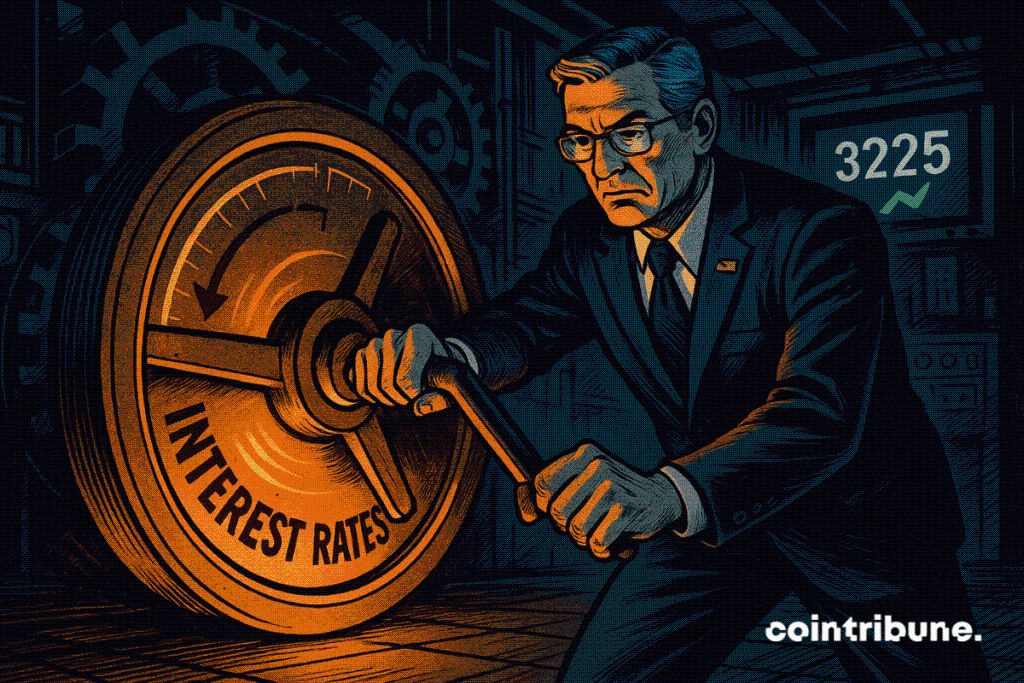Fed Debates Future Rate Path As Data Lags
The minutes of the Fed published on October 8 confirm an expected but delicate monetary shift. While the rate cut is now underway, the extent of the move by the end of the year still divides the committee. In a context of slowing employment, contained inflation, and government paralysis, this shift weighs heavily on market expectations. For crypto investors, sensitive to monetary policy signals, every Fed hesitation becomes a factor of volatility.

In Brief
- The U.S. Federal Reserve cut its key rate by 25 basis points at its September meeting, bringing the range to 4% – 4.25%.
- A consensus is forming in favor of further monetary easing by the end of this year, but committee members remain divided on the number of upcoming cuts.
- Economic projections anticipate two additional cuts this year, but part of the FOMC envisions a more aggressive pace, illustrated by Stephen Miran’s dissenting vote.
- The weakness of the labor market and the stabilization of inflation motivated this cautious shift, without dispelling uncertainties about the path ahead.
Growing Divergences Within the FOMC
At the conclusion of its September 16-17 meeting, the U.S. Federal Reserve voted by a large majority of 11 to 1 for a 25 basis points cut in its key rate , bringing the target range to 4 % – 4.25 %.
The minutes of this meeting note that “almost all participants noted that with the reduction of the target range for the federal funds rate at this meeting, the Committee was well positioned to respond quickly to potential economic developments.”
This direction is directly linked to a perceived deterioration in the labor market, which is pushing the Fed to adopt a more flexible stance.
The analysis of the economic context raises contrasting views among FOMC members, with arguments that reflect divergent interpretations of macroeconomic signals :
- Some members believe that “financial conditions are not particularly restrictive”, which would justify a wait-and-see approach ;
- Others consider that the economic slowdown is already noticeable and that preventive action is needed ;
- The role of tariffs in sustaining inflationary pressures remains an uncertainty mentioned in the discussions ;
- The federal shutdown, which delays the release of key data, further complicates the assessment of short-term economic risks.
In this context, the minutes show a vigilant but divided Fed, aware that its next decisions will have to adjust to still incomplete on-chain data and sometimes contradictory market signals.
Internal Disagreements and Employment Tensions
While the general direction of monetary policy is barely debated, divergences crystallized around the dissenting voice of Stephen Miran, appointed governor. Present for the first time at this meeting, Miran stood out by voting against the majority decision, preferring a 50 basis points cut.
In official documents, his name does not appear, but his opinion was explicitly mentioned in the post-meeting communication and confirmed in subsequent statements.
He also declared himself the only one favoring a much faster rate cut path than his colleagues. This position reflects a growing divide within the FOMC, between advocates of a gradual adjustment and those who argue for a more vigorous monetary easing, facing a more marked economic slowdown than anticipated.
Beyond the votes, the substance of discussions reveals growing concerns about the labor market, presented as the main factor driving the monetary adjustment.
While some members called for caution, emphasizing that financial conditions did not seem “particularly restrictive“, the risk balance has clearly shifted, with less pressure on inflation and increased attention to employment deterioration. Meanwhile, the question of tariffs imposed by the Trump administration was raised, without being considered a lasting inflation threat.
This situation could become even more complex in the coming weeks. Indeed, the U.S. shutdown is disrupting the collection of key macroeconomic data by the Labor and Commerce departments. If this administrative paralysis continues, the Fed, despite hesitations , will have to make its next decisions, especially at the October 28-29 meeting, without reliable data on inflation, unemployment, or consumption.
Disclaimer: The content of this article solely reflects the author's opinion and does not represent the platform in any capacity. This article is not intended to serve as a reference for making investment decisions.
You may also like
XRP’s ‘most bullish pattern’ targets $6 despite latest correction
How Aster, Lighter and Hyperliquid are competing for the next era of onchain trading
When Belief Becomes a Meme: The Life of Ju Coin and Crypto’s Self-Narrative
Everyone is the director of their own Ju coin life.

Virtuals Protocol: Why Are We Launching the New Launchpad Unicorn?
From convenience to conviction, Virtuals Protocol is reshaping the paradigm of shared ownership in the AI agent economy.

